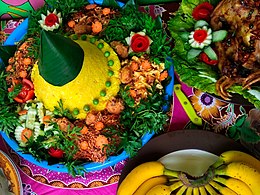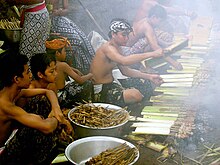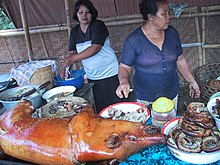Balinese cuisine

 |
| This article is part of the series on |
| Indonesian cuisine Masakan Indonesia |
|---|
|
|
Balinese cuisine is a cuisine tradition of Balinese people from the volcanic island of Bali. Using a variety of spices, blended with the fresh vegetables, meat and fish.[1] Part of Indonesian cuisine, it demonstrates indigenous traditions, as well as influences from other Indonesian regional cuisine, Chinese and Indian. The island's inhabitants are predominantly Hindu and culinary traditions are somewhat distinct with the rest of Indonesia, with festivals and religious celebrations including many special foods prepared as the offerings for the deities, as well as other dishes consumed communally during the celebrations.[2]
Rice, the primary grain is almost always consumed as a staple accompanied with vegetables, meat and seafood. Pork, chicken, fruit, vegetables and seafood are widely utilized, however as in most Hindu communities, beef is never or rarely consumed.[3]
Bali is a popular tourist destination, and the area has many cooking schools with daily courses of Balinese cuisine.[4] Night markets, warungs (food stands), and fruit vendors sell local delicacies.[4] Festivals include ornately prepared foods as part of the celebrations. As a popular tourist area, many westernized foods are also available as well.
History
[edit]This section needs expansion. You can help by adding to it. (August 2021) |
Ingredients
[edit]
Steamed rice is commonly consumed in every meal. Pork, chicken, seafood and vegetables are widely consumed. As Hindus however, Balinese never or rarely consume beef. This restriction is especially observed by those who belong to Brahmin and Kshatriya castes. Nevertheless, lesser Gusti (nobles) and common Balinese people might consume beef, albeit rarely.[3]
Spices include Kaempferia galanga (galangal), shallots, garlic, turmeric, ginger and Kaffir lime are used in Balinese cuisine. Balinese 8-spice is made with white pepper, black pepper, coriander, cumin, clove, nutmeg, sesame seed, and candlenut. Palm sugar, fish paste, and basa gede (a spice paste) are used.[5]
Fruits include rambutan, mangoes, mangosteen, bananas, jackfruit, passion fruit, nangka (jackfruit), pineapple, salak (snake fruit), duku, kelengkeng (longan), wani (white mango or Mangifera caesia), papaya, melon, oranges, custard-apple, coconut and durian.[6]
Traditions, serving and outlets
[edit]
In Hindu Balinese traditions, certain foodstuffs are served in religious rituals, used as an offering for gods. During religious ceremony, festively decorated fruits and foodstuff are brought to the temple as an offering. Balinese believed that certain foodstuff is an appropriate offering for certain deities. For example, pork is favoured by Batara Kala, while ducks are favoured by Hindu gods, such as Brahma. Certain rare foodstuff such as turtle meat is also used in rituals.
Balinese households usually purchase fresh ingredients from the local market every morning, cook and serve them in the late morning to be mainly consumed for lunch. The leftovers are stored to be heated again for family dinner. Other than homemade family dishes, Balinese cuisine are served from humble street side carts and warungs, to fancy restaurants in resorts and five-star hotels. Small family-run warungs are the budget options for street food, serving everything from family dishes for full meals, or snack foods.
Balinese warungs or restaurants usually specified on certain menu, for example there are restaurants that specialized on solely serving babi guling (suckling pig), bebek betutu (crispy duck), or nasi campur (Balinese mixed rice). Some warung specialized on selling tipat cantok (similar to kupat tahu) or nasi jinggo mixed rice.
Rice
[edit]
Bali has a strong rice agriculture tradition in Indonesia, as evidence through centuries old intricate network of sophisticated Subak irrigation system. The Balinese water temples regulates the water allocation of each village's ricefields in the region. Balinese Hinduism revered Dewi Sri as an important rice goddess.[2] Her and other deities colorful effigies made from colorful sticky rice are often made during religious ceremonies.
Spices and seasonings
[edit]
Basa gede, also known as basa rajang, is a spice paste that is a basic ingredient in many Balinese dishes.[2] Basa gede form the cornerstone of many Balinese dishes. Its ingredients include garlic, red chili peppers, Asian shallots, nutmeg, ginger, turmeric, palm sugar, cumin, shrimp paste and salam leaves (Indonesian bay leaf).[7]

Balinese dishes are punctuated by basa genep, the typical Balinese spice mix used as the base for many curry and vegetable dishes.[8] As well as bumbu (seasoning) used as a marinade. Tabia lala manis, which is a thin soy sauce with chili peppers, and sambal matah are popular condiments.[9]
Dishes
[edit]
Balinese foods include lawar (chopped coconut, garlic, chili pepper, with pork or chicken meat and blood), Bebek betutu (duck stuffed with spices, wrapped in banana leaves and coconut husks cooked in a pit of embers), Balinese sate known as sate lilit made from spiced mince pressed onto skewers which are often lemongrass sticks, Babi guling also known as cel eng guling (a spit-roasted pig stuffed with chili peppers, turmeric, garlic, and ginger).[9]
In Bali, the mixed rice is called nasi campur Bali or simply nasi Bali. The Balinese nasi campur version of mixed rice may have grilled tuna, fried tofu, cucumber, spinach, tempe, beef cubes, vegetable curry, corn, chili sauce on the bed of rice. Mixed rice is often sold by street vendors, wrapped in a banana leaf.
Betutu is eaten in Bali as well as Lombok, and West Nusa Tenggara. It is a roasted poultry dish (chicken or duck) with spices. Lawar is a traditional vegetable and meat dish in Bali Vegetable and meat dish served with rice. It consists of shredded unripe jackfruit, young banana flower, a liberal amount of pork rind bits, raw pig blood. These are mashed with herbs such as lemon grass, kaffir lime leaves, shallots, and garlic. Babi guling is a Balinese-style roast pork comparable to Hawaiian luau-style pig.
Other common Indonesian dishes are easily found, such as tempe and tofu are used. Sambal dishes are also served. Bakso, a meatball or meat paste made from beef surimi, can also be found.
List of dishes
[edit]

- Betutu, steamed or roasted poultry (chicken or duck) highly seasoned. A specialty of Bali.
- Babi Guling, roasted suckling pig, famous in Bali.
- Be Balung, pork (mostly) ribs soup, Be means meat and Balung means ribs.
- Iga Babi, Balinese pork ribs.
- Rawon babi, pork spicy stew similar to East Javanese rawon. This Balinese pork version however, is not using any keluak, thus the soup color is not black but rather light brownish grey instead.[10] This meat soup is usually served to accompany nasi bali or babi guling.
- Sate Babi, pork satay.
- Sate Lilit, spiced minced meat on a stick.
- Soto Babi, pork soto.
- Mujair Nyat-Nyat, Mujair fish cooked with Balinese spices served just like a fish in a mud (Nyat-Nyat means mud). It is easily found in Bangli, Northern Bali.
- Be Nyat-Nyat, just like Mujair Nyat-Nyat but this one is meat (mostly pork).
- Lawar, mixed vegetables, minced meats (pork or chicken or sometimes no meat if it is a vegetarian Lawar), spices, and other ingredients. There are two types the white one called Lawar Putih and the red one called Lawar Barak (the red colour comes from the meat bloods that mixed into it).
- Jukut Urab, Balinese mixed vegetables (a bit like salad) mixed with grated coconut.
- Tipat Cantok, Balinese salad with peanut sauce dressings. It contains tipat (a kind dumpling made from steamed rice wrapped in coconut leaves), vegetables, and tahu (an Indonesian tofu) .
- Nasi Bali, rice with various dishes.
- Nasi jinggo, a small portion of rice with various dishes wrapped with banana leaves (but nowadays can be found with kertas minyak). It is often found on pathway (from evening till night) and in warung (in the morning) and sometimes eaten as a breakfast.
- Basa Genep, Balinese bumbu or spices commonly used as flavouring agent for chicken, fish or meat.
- Sambal Matah, literally means 'raw sauce' (Sambal is Indonesian sauce, Matah is a Balinese word means raw). It contains minced garlics, onions, chili peppers, shallots, lime, and lemongrass mixed with coconut oil (the most important ingredient; it cannot be changed with any other oils, coconut oil can be easily found in Bali since it is a very useful oil for Balinese and the grandparents still made it homemade).
- Sambal Bongkot, a Balinese sambal with Bongkot (Torch Ginger/Kecombrang).
- Sambal Embe, a Balinese Sambal made from sautee sliced garlic, onions, chili peppers, salt, and terasi (condiment made from pounded and fermented shrimp or small fish). It is also used in a Balinese traditional offerings.
- Tipat cantok, a Balinese tipat rice cake with vegetables served in peanut sauce dressing, akin to gado-gado and pecel.
- Urutan, a Balinese traditional pork (mostly) sausage.[11][12]
- Laklak, a Balinese traditional little pancake with grated coconut and melted palm sugar.
- Bubuh Sum-Sum, rice porridge with palm sugar sauce and grated coconut.
- Bubuh Injin black sticky rice with grated coconut and melted palm sugar.
- Bantal, packages of sticky rice, coconut, sugar and fruit (often bananas or sometimes orange rind or even mango essence).
- Sumping Waluh, steamed cakes from rice flour mixed with Waluh (Balinese word for pumpkin) wrapped in banana leaves.
- Sumping Biu, steamed cakes from rice flour with Biu (Balinese word for banana) inside of it and wrapped with banana leaves.
- Kopi luwak (luwak coffee), also called civet coffee or “poo coffee”. It is named after the practice of weasel-like animals called civets let loose into coffee plantations at night to eat coffee berries then defecate out the coffee beans which are collected, washed and roasted over a fire.[5]
- Jukut Undis, is a traditional soup dish made from Gude beans (also known as kayo beans or Cajanus cajan), a petite black legume reminiscent of soybean but with a deep black color.
- Jukut Ares is a flavorful Balinese soup that features the delicate and succulent stalks of young banana trees as its main ingredient.
Beverages
[edit]
Balinese coffee, Kopi Bali, and hot tea, teh panas are popular. Tea is often served with sugar (gula) and condensed milk, susu. Brem is Balinese rice wine alcoholic beverage. It is made from fermented mash of black or white glutinous rice (known as Ketan) using a dry-starter, which called as Ragi tape.[13] Daluman is Balinese ice drink made with cincau jelly leaf, coconut milk, palm sugar syrup, and shaved ice. It provides a cooling sensation and aids digestion.
See also
[edit]References
[edit]- ^ "Flavours of Indonesia, Balinese Food". Destination Asia. Retrieved 26 August 2014.
- ^ a b c Vivienne Kruger (2014). Balinese Food: The Traditional Cuisine & Food Culture of Bali. Tuttle Publishing. ISBN 9781462914234.
- ^ a b Miguel Covarrubias (2015). Island of Bali, Periplus classics. Tuttle Publishing. p. 87. ISBN 9781462917471.
- ^ a b "Bali: The Online Travel Guide - Food". Home.mira.net. Archived from the original on 2013-07-30. Retrieved 2013-07-01.
- ^ a b Daniel Noll and Audrey Scott (2011-07-22). "Bali Food (An Overview of Cuisine in Bali)". Retrieved 2013-07-01.
- ^ "Guide to tropical fruits in Bali". Bali Blog. 2005-03-02. Archived from the original on 2015-09-23. Retrieved 2013-07-01.
- ^ O’Gilvie, Diana (14 October 2012). "Learning Bali's true flavors". The Jakarta Post. Retrieved 14 January 2015.
- ^ Betteridge, Ashlee (Apr 2, 2010). "Nasi Campur: Rice With a Side of Serendipity". Archived from the original on 25 May 2014. Retrieved 22 May 2014.
- ^ a b [Traditional Balines Foods] Ehow
- ^ "1 resep rawon babi enak dan sederhana". Cookpad (in Indonesian). Retrieved 2018-01-17.
- ^ "Ku De Ta: Sacred table surprises - Lifestyle - The Jakarta Post".
- ^ "Balinese roast pig: The five best places to eat a decadent delight". 31 January 2018.
- ^ Kuliner Rakyat Resah.;
Further reading
[edit]- Holzen, Heinz Von (2008). Bali Unveiled: The Secrets of Balinese Cuisine - Heinz Von Holzen. ISBN 9789812613738. Retrieved 2013-07-01.
- Holzen, Heinz von (2010). Street Foods of Bali - Heinz von Holzen. ISBN 9789812615251. Retrieved 2013-07-01.
- Fire Islands: Recipes from Indonesia. Eleanor Ford. (Murdoch Books, 2019)
- Balinese Food: The Traditional Cuisine and Food Culture of Bali. Dr. Vivienne Kruger, Ph.D. (Tuttle Publishing, April 2014)
- Forty Delicious Years 1974-2014. Murni's Warung, Ubud, Bali: From Toasted Sandwiches to Balinese Smoked Duck. By Jonathan Copeland, Rob Goodfellow, and Peter O'Neill (Orchid Press, Jun 1, 2014)
- Secrets of Bali, Fresh Light on the Morning of the World, Jonathan Copeland and Ni Wayan Murni,(Orchid Press, September 2010)
External links
[edit] Media related to Cuisine of Bali at Wikimedia Commons
Media related to Cuisine of Bali at Wikimedia Commons
